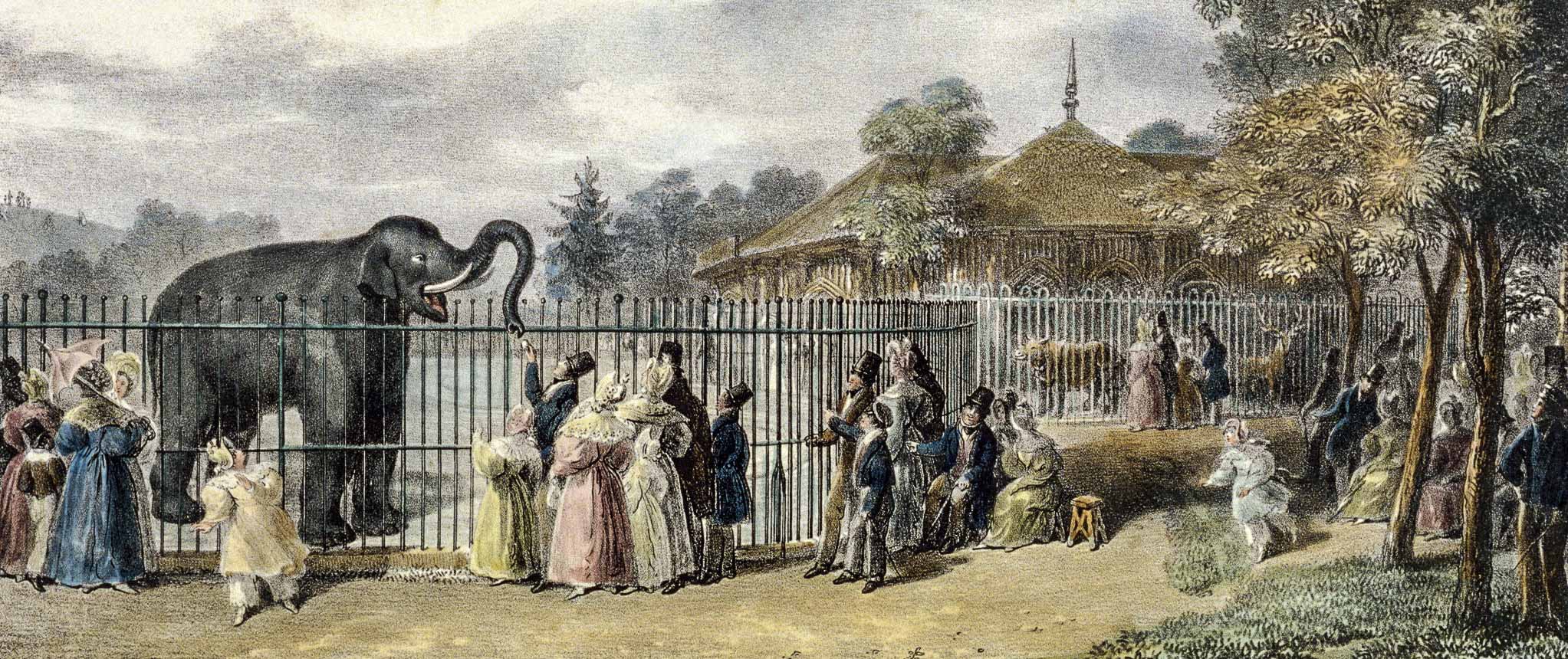
On a long road to understanding a multitude of species. Figure 1: George Scharf’s 1835 rendering of the London Zoo. [o]
HUMAN ATTACHMENTS, HUMAN LOSSES
The marine biologist Steve Simpson, speaking recently to the Guardian, described a return visit to the Great Barrier Reef, after a major bleaching incident: “it was completely devastating to see individual corals that we knew and loved and had spent so long studying, now dead.” As a regular visitor to particular corals, Simpson had developed genuine attachments to them and keenly mourned their deaths. For most of us, though, accounting for non-human deaths means thinking in terms of species rather than individuals. We speak most frequently, not of death, but of extinction.
Of course, species-oriented thinking is essential to our tracking of the vicissitudes of biodiversity, and this is a profound human responsibility. Paying closer attention to the extraordinary diversity of living species is the first and most important step toward caring for that diversity and taking steps to protect it.
Take the oft-feared spider, which many of us routinely kill, not because all spiders pose a threat to us, but because we fail to differentiate between the relatively small number of venomous spiders and all the other benign and beneficial spiders we encounter, indoors and out. In learning to see the differences in kind between spider A and spider B — that is, in coming to understand that our very broad category of “spider” encompasses more than 50,000 different species — we might start to care more about spiders in general, including individual spiders we might once have feared and stomped on without hesitation. Moreover, by experiencing the world of spiders as a miracle of complexity, we stand a good chance of recognizing that the facts of evolution and speciation, generally, are far more dazzling than, say, any of our religions’ creation-myths.
Not spiders in general, but what about this particular Spruce-fir moss spider?
It’s true that a species is merely a category — an abstraction of shared characteristics. But a species is a far more specific and distinctive category than “spiders” or “trees.” Many human beings are happy enough to see rainforests cut down and replaced with palm oil plantations — if they think of both as just a bunch of trees. But a rainforest is a vast assortment of strikingly different kinds of plants that would take a dozen lifetimes even to begin to describe — a complex community of notably variegated forms, intricate relationships, and undiscovered stories. In contrast, a palm oil plantation, while still teeming with life, is a radically diminished and impoverished community of nearly identical trees. Appreciating the difference means being able to look at individual organisms, including even the commonest and least charismatic, with engaged and appreciative eyes.
Moreover, we might begin to ask not just “What of the Spruce-fir moss spider?” or “What of the African baobab tree?” (both are endangered species) but also “What of this particular Spruce-fir moss spider?” and “What of this individual African baobab tree?” Greater species-awareness among humans is vital to the survival of all species, including our own. And it’s also the surest route to the recognition of the members of any given species as individual beings, with their own distinct place in the world, their own sensorium or consciousness, and, in so many cases, their own particular relationship to you and to me.
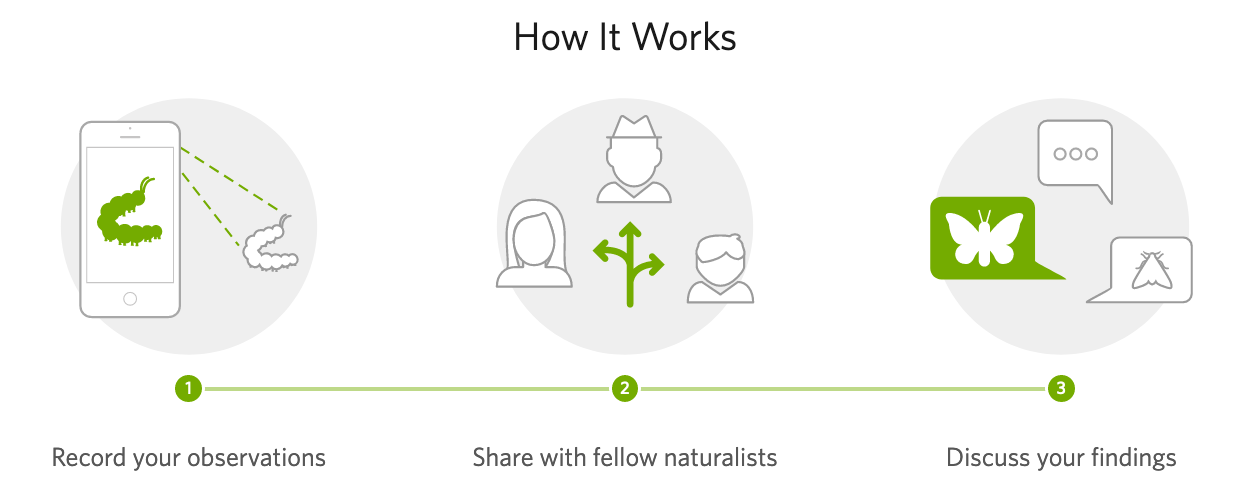
Navigating the iNaturalist app. [o]
TRADITIONAL ECOPOETICS
Many years ago, my partner developed a passion for mollusks. His study of land snails involved him in a network of far-flung correspondents, some of whom exchanged shells from their respective parts of the world in order to expand their private collections. One day, Matt received a small package from a colleague in Zimbabwe and discovered that, in among the empty shells, there was a still-living snail — a stowaway garden snail (Cornu aspersum) who had unwittingly traveled almost ten thousand miles from southern Africa to our home in central New Jersey. Matt did his best to keep our visitor alive in a makeshift terrarium. But, one night, the snail escaped and found its way to a nearby glass — lured, no doubt, by the sweet-smelling remnant of orange juice it contained and in which we found it, drowned, the next day. We’d both become somewhat attached to our visitor, and because, at that time, I happened to be writing a book about mourning poetry, I composed an elegy for the drowned snail. Sort of like a child who finds a dead sparrow in her backyard and implores her parents to help her bury the bird, I’d adapted a traditional form for mourning human losses to the commemoration of a radically different kind of creature.
Literature and art are full of memorials to beloved non-humans — chiefly charismatic megafauna like horses, cats, dogs, and birds. But these tributes acknowledge only the tiniest fraction of non-human deaths. Occasionally subjecting a very few non-human beings to conventional human mortuary practices sidesteps the need for more appropriate and practical collective measures — measures to account for all the other losses that occur, both in full view of sympathetic humans and also in all the places where human sentiment is either absent or proscribed: factory farms, bulldozed jungles, polluted oceans, burning forests, toxic sediments. These deaths weigh on our spirits more than most of us realize, or are willing to acknowledge, in large part because most of us don’t have readily available ways of shaping and sharing our experiences of non-human losses.
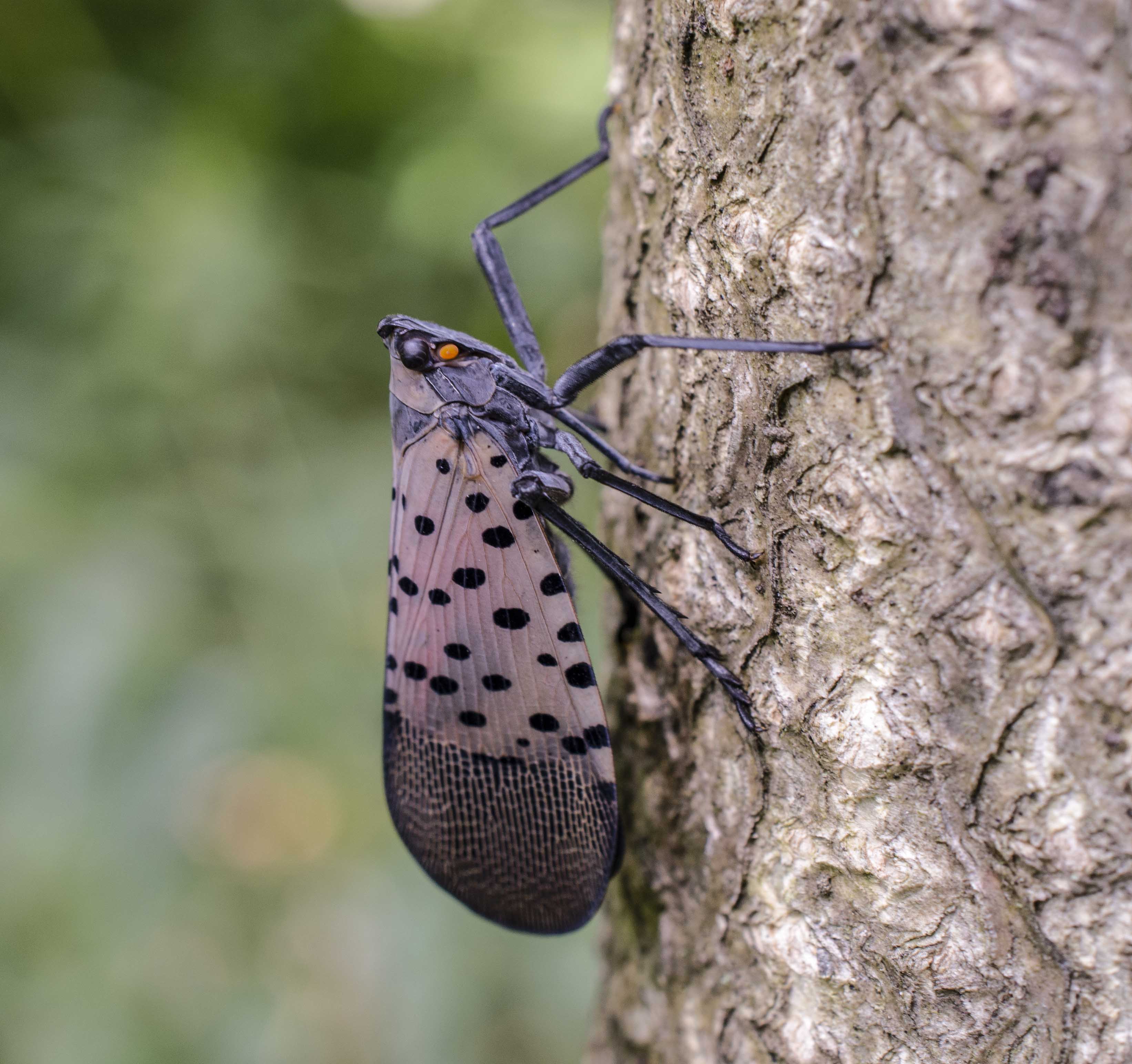
Figure 2: Spotted lanternfly (Lycorma delicatula), observed.
iNATURALIST AS AN ECOPOETIC PLATFORM
A new public science project is beginning to change that. iNaturalist (iNat, for short) is a free app that allows scientists and amateurs alike to post their own images of individual animals, plants, fungi, chromists, protozoans, and bacteria. To participate, you simply download the app and begin uploading your “observations.” In iNat lingo, an “observation” is a record you have created of your sighting of a particular organism — wherever you happen to encounter it in its proper (non-domesticated, non-cultivated, non-captive) state. Most observations take the form of digital photographs, but video-clips and sound-recordings can be uploaded as well and combined within a single observation. Basic metadata (e.g., date, time, geolocation, altitude, etc.) are captured automatically by most cameras and smart phones, and further data (e.g., circumstances of discovery, technical challenges faced, whether an organism is indigenous or invasive, etc.) can be entered manually. The iNat “observation,” in my view, is what (thus far) comes closest to a viable, innovative, and scale-appropriate ecopoetic form (or genre) for the expression of trans-species attachment and loss. Thus far, the iNat “observation” is the most flexible and inexpensive worldwide platform for the expression of trans-species attachment and loss.
Here’s an example of how I’ve used it. When an East Asian species of planthopper called the Spotted lanternfly began to establish a strong foothold as an invasive species along the U.S. mid-Atlantic — posing a serious threat to the agricultural industry in Pennsylvania and elsewhere — iNatters went into high-gear. iNat observations of Spotted lanternflies exploded, tracking their proliferation with thousands of individual observations, which often included comments on their spread and on what might be done about it (Figs. 3 and 4). These observations also documented individual Spotted lanternflies as they went about their own business in a new environment — and displayed to fresh eyes their considerable beauty.
If you already know that what you’ve encountered is a Spotted lanternfly, you can enter that information yourself. But, if you’re unsure, iNat’s AI software can identify it — along with thousands of other species — for you. Once you’ve uploaded your observation, anyone can view it, and fellow iNatters can correct or confirm your species designation, sometimes debating the fine points of taxonomic distinctions, or commenting in more personal ways. When at least two iNatters are in agreement about classification — and if no one else dissents — iNat tags your observation as “research grade,” which alerts scientists and other researchers to your observation’s value for species-based investigations.
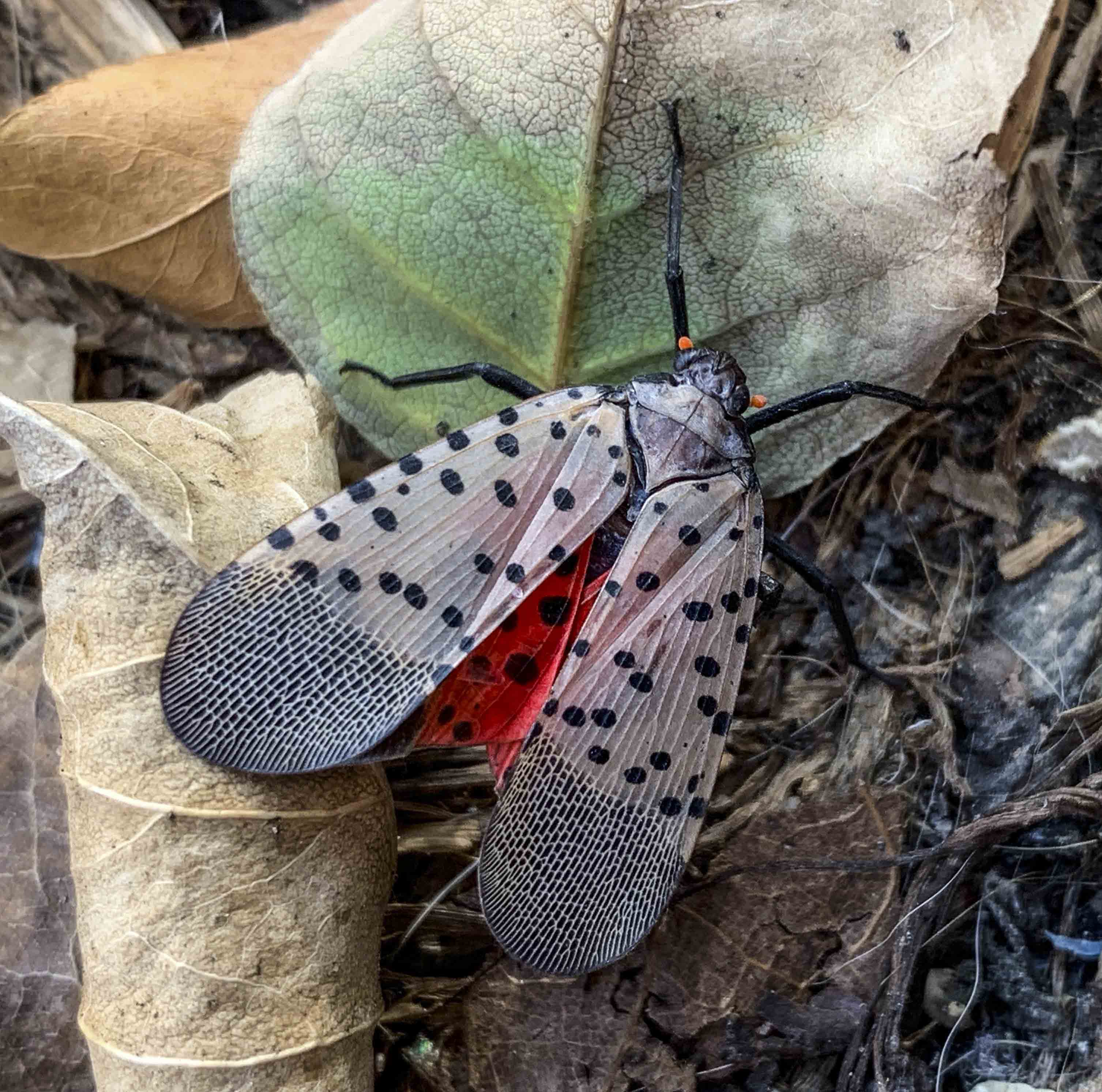
Figure 3: Spotted lanternfly (Lycorma delicatula), August 17, 2019, in Norristown PA. observed September 24, 2019, in Philadelphia PA. Photo by the author.
But the further, crucial dimensions of iNat, for the kind of ecopoetic program I’m envisioning, are: 1) That every observation is of an individual organism, encountered by the observer in the organism’s own environment, whether it’s untouched wilderness or an urban vacant lot; and 2) That you can upload many different observations of different organisms of the same species, emphasizing the organism’s uniqueness, rather than its typicality. These possibilities are what make iNat especially valuable, not only as an increasingly comprehensive digital field guide and research database, but also as a permanent record of actual human encounters with particular beings in particular places at particular times. Moreover, while most of the organisms are alive at the time of observation, many are not; and they’ll all be dead eventually, according to varying circumstances and life-spans.
Recently, I happened to encounter for the first time what is possibly the world’s largest unicellular species — a kind of alga commonly known as Sailor’s eyeball — on the island of Vieques. Left behind by the tide, they dotted the beach: not yet dead, but dying, each one with its own distinctive coloring and translucency, like any human sailor’s eyeball. The one pictured here (Fig. 4) has by now collapsed and disappeared — but not the nearby Coconut palm, which had withstood, among other things, the ravages of Hurricane Maria in 2017 (Fig. 5). Welcoming images of the dead and the living is one of the ways iNat provides for an integrated ecopoetics of attachment and mourning.
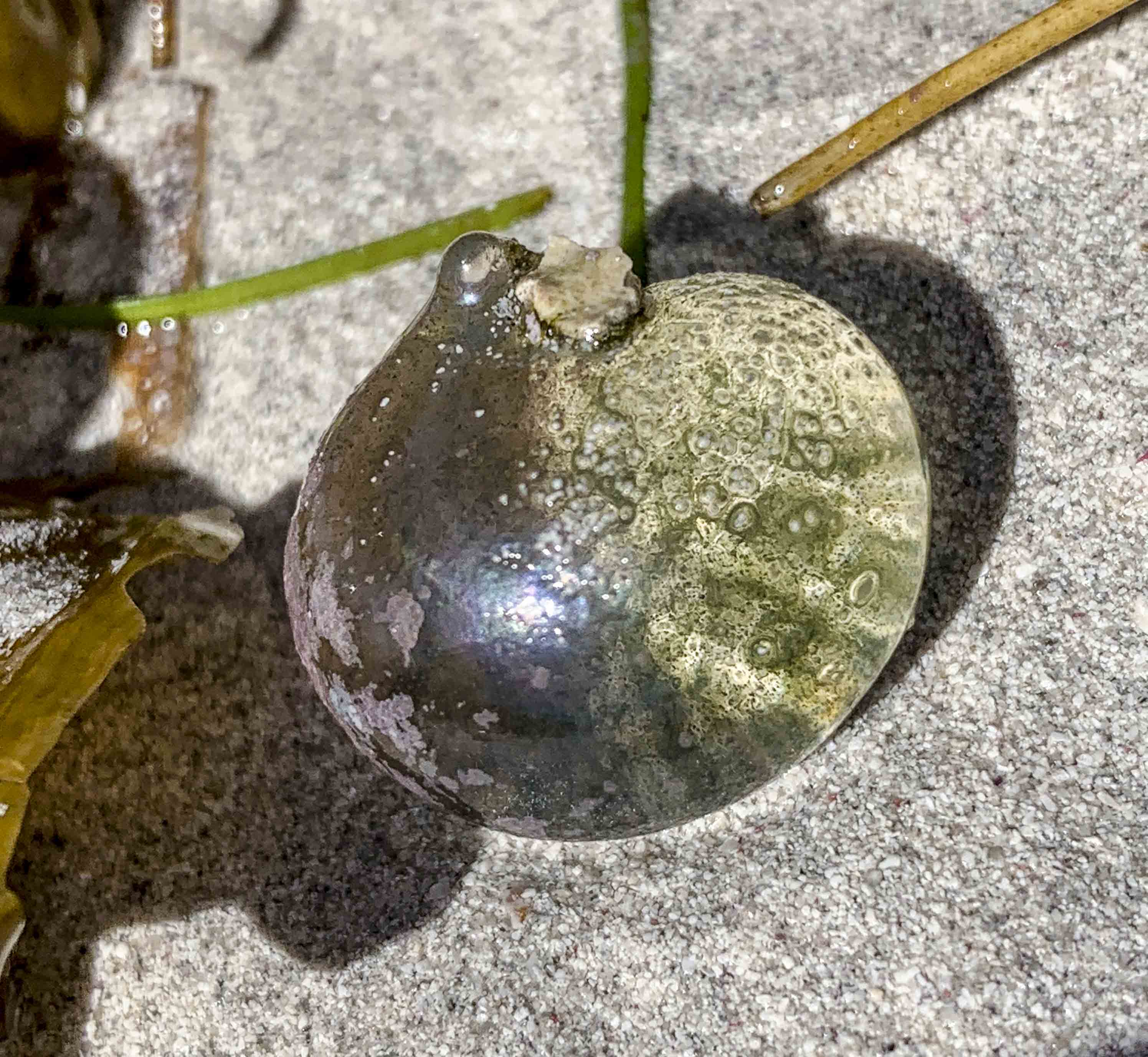
Figure 4: Sailor’s eyeball (Valonia ventricosa). Photo by the author.
The Internet has been host to many crowd-sourced biological observation platforms, apps, and games, including eBird, BudBurst, FoldIt, and Encyclopedia of Life. But iNat is by far the most widely used, and it has the potential to become the largest and most important public science project of the digital era — one with deep roots in humankind’s predilection for collecting, identifying, and preserving specimens of other life-forms. In addition, iNat has the potential to channel and transform that predilection into an unprecedented global community of observers, working together both to commemorate non-human losses and to inspire and coordinate life-affirming feelings, practices, research, and policy. To date, iNat boasts approximately 850,000 contributors from 250 countries, a database of more than 30,000,000 observations, and AI software that can recognize at least 20,000 different types of organisms. These numbers are impressive, but they will have to expand considerably (especially beyond North America and Europe) to have a truly transformative and lasting effect on human/non-human relations — a comprehensive shift, in other words, from melancholic depredation to vital and hitherto unpracticed forms of shared attachment.
FROM COLLECTING TO RELATING
Long before digital “observations,” there were physical “specimens.” Some of them were living (captive or cultivated), but most were defunct remnants: shells, skins, fossils, skeletons, dried flora, taxidermized fauna. A specimen is something both visible (Lat. specere: “to look at”) and representative (Lat. specimen: “example”): a tangible individual, or part of one, that can be owned, examined, preserved, displayed, inventoried, and studied, as well as a symbol of other organisms like itself. Historically, the forensic as well as aesthetic value of such specimens extended, of course, to their depiction by artists, scientists, and dedicated amateurs, whose words and images have been circulated, preserved, admired, and studied by vast numbers of people around the world — people who could never hope to see this or that organism “in real life,” even if it hadn’t already become extinct.
Indeed, collecting, identifying, and preserving specimens of other life-forms has been a near-constant human activity, from the pre-historic menagerie at Hierakonpolis (c. 3500 BCE), to the zoological gardens of the ancient Greek city-states, to the many royal collections at Tenochtitlan, Assyria, Zhou, Judah, Babylonia, and Vienna, to the private, early-modern Wunderkammern (“cabinets of wonders”) of wealthy elites, to the vast public zoos, aquaria, and safari parks of nineteenth-century London, Dublin, Paris, Nova Scotia, Wroclaw, Melbourne, Berlin, San Francisco, and New York. In tandem with various museums, institutes, and societies, they stressed their role in conservation, research, and education in order to justify displaying beings both living and dead for the sake of popular entertainment (Figs. 1 and 6).
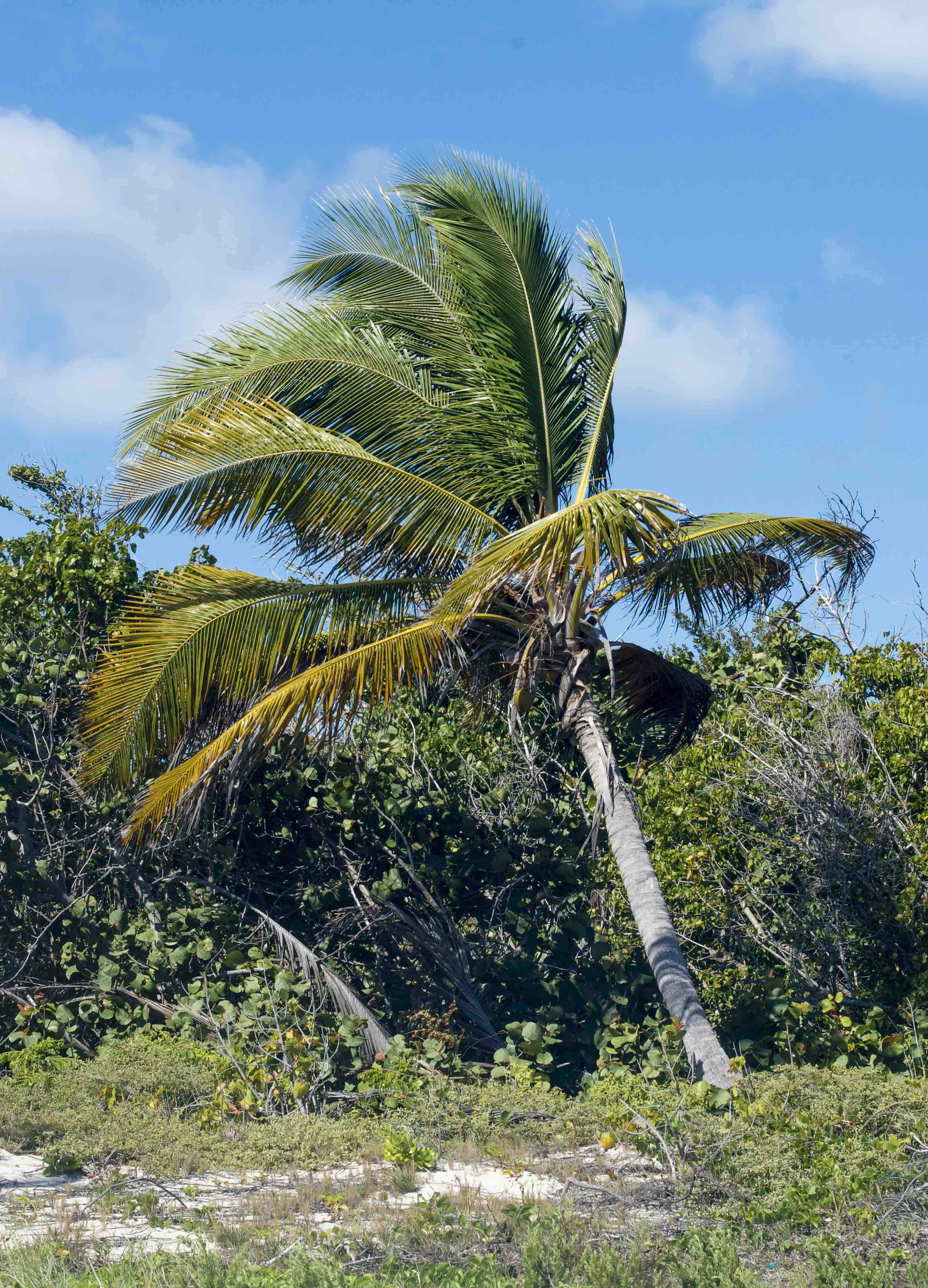
Coconut Palm (Cocos Nucifera).
Specialized science and mass entertainment continue, at least indirectly, to reinforce and to celebrate the “dominion” over “all the earth” ostensibly promised to human beings by the Judeo-Christian God in the Book of Genesis. For many thousands of years, that “dominion” was relatively benign. Before the modern period, human activity had little effect on rates of speciation and extinction. Non-human drivers, including geological and geothermal disruptions and asteroidal impacts, had until then accounted for all major extinction events. No human being had ever experienced such an event, not until we began precipitating them ourselves. Over the past five centuries, human drivers, such as population growth, land clearance, and — since the mid-twentieth century, especially — rapidly increasing rates of fossil fuel consumption and technological spoliation, have so dramatically tipped the balance in favor of extinction that we have inaugurated a new epoch of geologic time, the Anthropocene, during which countless species and an enormous percentage of the world’s total biomass have already been destroyed. And the prospect of an extinction event so comprehensive that the human species itself would cease to exist is increasingly plausible.
FROM HUMAN EXCEPTIONALISM TO TRANS-SPECIES RELATEDNESS
Ironically, Homo sapiens is the only species (at least thus far) that iNat will not classify as “research grade.” If you post a snapshot of your human cousin Greta as an observation, she will be designated — along with any photos of your pet canary, or your sled dog, or a giraffe from your local zoo — as “casual,” which is iNat lingo for: “This really belongs on Facebook or Instagram.” Beyond the legal and ethical barriers against displaying human beings as research subjects, in this practice there is also the lingering sentiment of human exceptionalism — as well as the shameful memory of times when human beings themselves were displayed in cages, sometimes alongside animals of other species. In 1906, for example, the Bronx Zoo exhibited a Congolese pigmy named Ota Benga, who was caged with chimpanzees, an orangutan, and a parrot. Humans were also displayed in cages at the 1931 Paris Colonial Exposition and as recently as 1958 at the Brussels World’s Fair.

Figure 6: The 17th-century Wunderkammer of the Danish Physician, Ole Worm. [o]
Moreover, as with any social media platform, there are legitimate concerns about the collection (advertent or inadvertent, benign or malicious) of Personally Identifiable Information (PII). Just like Facebook, Instagram, TikTok, Tinder, Grindr, GoogleMaps, Spotify, Amazon, and all the other real-time trackers of our every movement, purchase, mood, and predilection, iNat could end up further enabling the datalogical exploitation of its human contributors. It could also abet the exploitation of non-human subjects by revealing their precise locations to hunters, poachers, and collectors. For this reason, iNat automatically obscures the locations of many of the most endangered species.
But the same computational processing power and essentially limitless digital storage space that make each one of us individually identifiable and vulnerable in cyberspace also now make it possible to think of all non-human existents, not only as members of innumerable, mind-bogglingly diverse species, but as individuals as well. There will never be digital portraits of every single Sailor’s eyeball or every individual coral. But comprehensive collections of data-supplemented, digital, in situ portraits — at least of larger vertebrates and plants — could plausibly be part of the not-too-distant future. For example, The Executioner clownfrog that I observed on a nightwalk in Ecuador (Fig. 8) is now part of an ever-expanding album of other human encounters with members of this species throughout the northern part of that highly biodiverse country (Fig. 9).
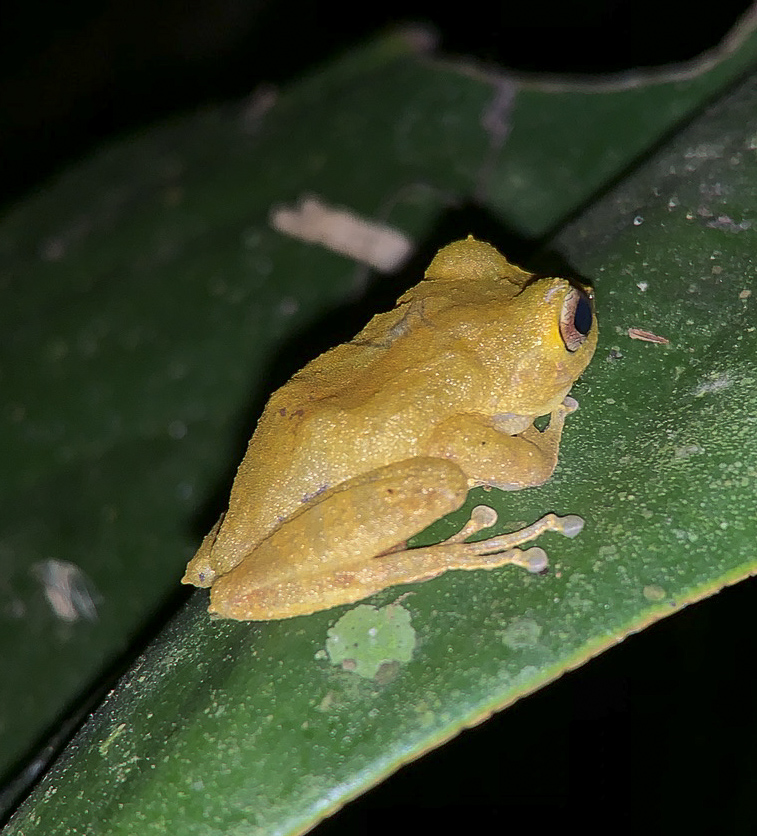
Figure 8: Executioner clownfrog (Dendropsophus carnifex),
With the proliferation of such “family albums,” species-blind or species-only forms of human thinking about non-human organisms could eventually give way to radically different thought patterns. We could think of ourselves as not only as belonging to one species among many, but also as individual beings among many other human and non-human individuals. This would not and should not mean projecting onto other lifeforms the brutal ideology of neoliberal individualism. But it could mean, instead, the emergence of a comprehensive ethos of intersubjectivity that reaches beyond exclusively human relationality. If iNat — or whatever might replace it as further technological potentials are realized — continues to evolve successfully, it could become the world’s leading multimedia platform for a revolutionary ecopoetics of trans-species relatedness. ≈ç
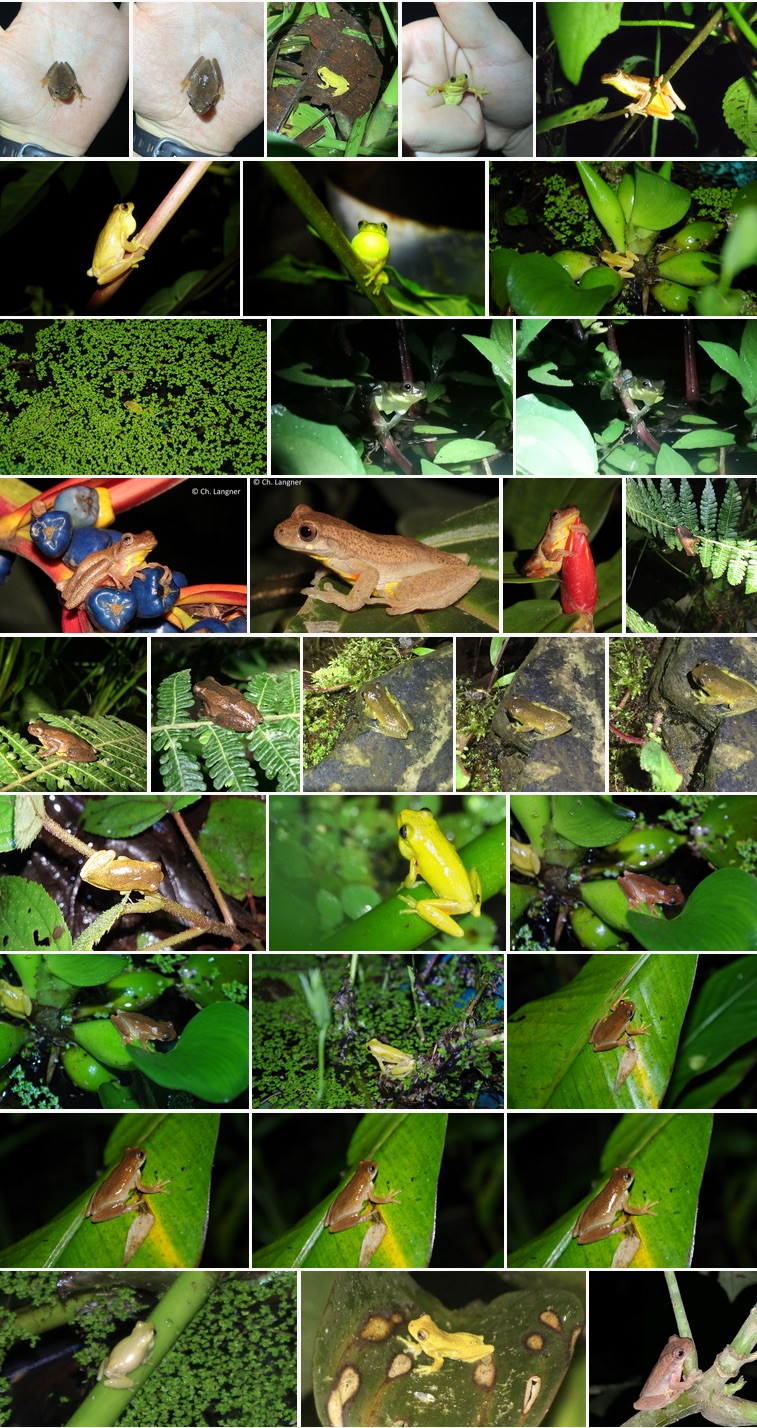
Figure 9: A page from iNaturalist displaying some of the Executioner Clownfrog observations. [o]

MAX CAVITCH is Associate Professor of English at the University of Pennsylvania, where he is also an affiliated faculty member of the programs in Comparative Literature, Gender, Sexuality and Women’s Studies, and Psychoanalytic Studies. He is the author of American Elegy: The Poetry of Mourning from the Puritans to Whitman (2007) and numerous articles. Max also edits the blog, Psyche on Campus. He lives in Philadelphia. View his page on the UPenn site.

Comments
Max, thank you for this…
Max, thank you for this essay, it is so well developed, and I support the message. I appreciate your suggested antidote to our fear of spiders — to narrow it down to a micro view and get to know the wonders of a spider. I love your description of the Sailor's Eyeball scene; many of them left behind by the tide, dotting the beach. Each one…distinctive…like any sailor’s eyeball. I especially like the story of the stowaway snail you and your Matt got attached to, and you memorializing it in a poem. I also liked the editor’s lead-in to your piece.
Thanks very much, Teri! And…
Thanks very much, Teri! And apologies for the belated reply: I only just saw your comment from last May — which seems, of course, like a lifetime ago. Today I'm on the Gulf Coast of Florida, encountering lots of new (to me) beings: ibises, sea grapes, ballmoss, alligators, zebra longwings, and cocoplums--all quite wonderful.
This was an engaging read,…
This was an engaging read! I think a lot about the Anthropocene and projections of neoliberalism onto the environment (i.e. the palm tree is meritocratic in a way that the rain forrest is not). Seemingly patterns of thought inform patterns of consumption...
As an undergraduate I was inspired by Fred Dretske's naturalism & non-reductive physicalist ontologies (the real world, living things exist and we do NOT need a causal why to explain behavior in the language of chemistry and physics). It seems like iNaturalist is an application in parallel to these interests, I look forward to exploring!
Add new comment